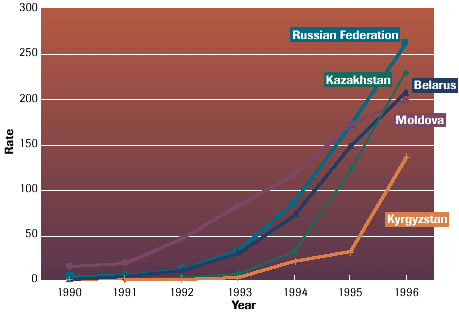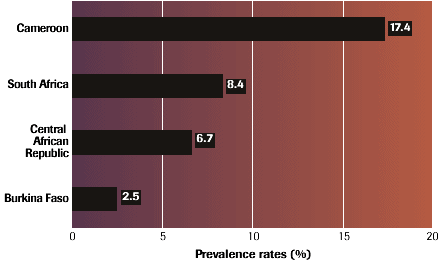|
Contents
Syphilis
In Western Europe, syphilis prevalence has declined substantially
since the peak after the second World War, with incidence rates
below 5 per 100 000 in the majority of countries.42,
43, 44
In the USA, trends of congenital syphilis began to decline in
1992 after an increase that follow a national syphilis epidemic
in 1980s and early 1990s. Rates of congenital syphilis declined
from 78.2 in 1992 to 20.6 per 100 000 live births in 1998, with
high rate in the south-eastern United States and among minority
racial/ethnic populations. The trend observed is parallel with the
trend for primary and secondary syphilis.46
| Box
5. Basic facts about Syphilis |
|
Syphilis is the classic example of
a STI that can be successfully controlled by public health
measures due to the availability of a highly sensitive diagnostic
test and a highly effective and affordable treatment.
- Clinical manifestations:
ulceration of the uro-genital tract, mouth or rectum, If
untreated, this is followed by a more generalised infection
which is usually characterised by disseminated muco-cutaneous
lesions. There may be fever and general malaise, as well
as hair loss and mild hepatitis.
- Complications: pregnancy
wastage (abortion, premature delivery, and stillbirth) neonatal
or congenital syphilis that occurs in about a third of new-born
babies of women with untreated syphilis. Disorders of the
musculo-skeletal, cardiovascular and nervous systems in
the final stage of the disease (tertiary syphilis)
- Diagnosis: Screening test
is simple and relatively cheap but not always available
in developing country laboratories.
|
In contrast with the decline in rates observed in Western Europe,
since 1989 there has been an alarming increased of the rates in
the newly independent states of the former Soviet Union. Syphilis
incidence has increased from 5-15 per 100 000 observed in 1990 to
as high as 120-170 per 100 000 of population in 199647
(Figures 10 and 11).48
| Figure 10. Syphilis prevalence
rates (%) in Baltic countries, 1990-96 |
 |
|
Figure 11. Syphilis prevalence rates (%) in former Soviet
Union countries, 1990-96
|
 |
In the Western Pacific, relatively high syphilis prevalence rates
are found in Cambodia (4%), Papua New Guinea (3.5%) and the South
Pacific (8%).49
In Mongolia, syphilis rates showed a decreasing trend during 1983-93
from 70 to 18 cases per 100 000 population, followed by an increase
to 32 cases per 100 000 in 1995, with a 1.5 3.0 fold higher
rate amongst the 15-24 age group.50
In the eastern Mediterranean Region, in 1997, the highest syphilis
prevalence rate amongst pregnant women was reported by Djibouti
(3.1%), followed by Morocco (3.0%) and Sudan (2.4%). Amongst blood
donors, the highest prevalence was seen in Morocco (1.3%), followed
by Qatar (1.1%).51
In Africa, syphilis prevalence rates amongst pregnant women varies
from 2.5% in Burkina Faso to 17.4% in Cameroon (Figure 12).52,
53, 54,
55
|
Figure 12. Syphilis prevalence rates (%), pregnant women
in Africa, 1990s
|
 |
Prenatal screening and treatment of pregnant women for syphilis
is cost-effective, even in areas of prevalence as low as 0.1%. In
South Africa, peri-natal death was 19.4 times more likely if incomplete
treatment or not treatment at all was received.56
| Table 4.
Estimated new cases of syphilis (in million) among adults, 1995
and 1999 |
|
Region |
1995
|
1999
|
| Male |
Female |
Total |
Male |
Female |
Total |
| North America
|
0.07 |
0.07 |
0.14 |
0.054 |
0.053 |
0.107 |
| Western Europe
|
0.10 |
0.10 |
0.20 |
0.069 |
0.066 |
0.136 |
| North Africa
& Middle East |
0.28 |
0.33 |
0.62 |
0.167 |
0.197 |
0.364 |
| Eastern Europe
& Central Asia |
0.05 |
0.05 |
0.10 |
0.053 |
0.052 |
0.105 |
| Sub Saharan
Africa |
1.56 |
1.97 |
3.53 |
1.683 |
2.144 |
3.828 |
| South and South
East Asia |
2.66 |
3.13 |
5.79 |
1.851 |
2.187 |
4.038 |
| East Asia &
Pacific |
0.26 |
0.30 |
0.56 |
0.112 |
0.132 |
0.244 |
| Australia &
New Zealand |
0.01 |
0.01 |
0.01 |
0.004 |
0.004 |
0.008 |
| Latin America
& Caribbean |
0.56 |
0.70 |
1.26 |
1.294 |
1.634 |
2.928 |
| Total |
5.55 |
6.67 |
12.22 |
5.29
|
6.47 |
11.76 |
Previous
section | Contents
| Next section
|